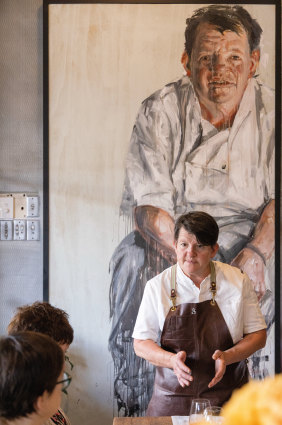

Annie Smithers in front of Daniel Butterworth’s portrait of her, a finalist in the 2016 Archibald Prize.Credit: Simon James
I remember very little from my first weeks there, other than a sense of terror, fatigue and confusion. I knew nothing about working in a team, and I knew almost nothing about cooking. Pretty quickly I learnt about some basics, as Alain was a bit of a shouter. As a new employee, I had come in during a menu cycle so was a bit of an odd-jobs person. My sense of purpose transformed very quickly once the seasonal menu changed, and I was given “a list”. Stephanie’s former training as a librarian meant that she was exceptionally organised. And her knowledge of how a French kitchen worked refined that organisation even further.
My first official position was on the entrée section. Picking parsley, cleaning radishes, clarifying butter, toasting crumbs, picking chervil, buttering coddled egg vessels. These are the very first tasks that build and build and build to create a cook; tasks that I still do today. I now grow the radishes I serve, and each time I pull one from the earth, or wash it and take away the outer leaves, or place it on a plate with a slice of unsalted butter and a small pile of salt, I hear her voice explaining the joy of a radish smeared in the butter, dipped in the salt, with a little rejoinder of, “It’s how the French eat them, Anne.”
By the time the next menu change took place, I felt I had come into my own. I was placed in the pastry room. The system in the kitchen was that each apprentice worked with a more senior colleague, allowing them to be supervised and instructed on a day-to-day basis. The pastry room was a separate space that everyone passed through on their way to the back sinks and coolroom. It was less intense than the main kitchen and only had two full-time inhabitants.
This is possibly where I fell in love with cooking.
Four decades from our first meeting, Stephanie is one of my closest friends. But what that first meeting kindled was a love affair with cooking and restaurants. What I learnt there propelled me out of one universe into another: the torrid, infatuating, adrenaline-rich world of the restaurant kitchen. Everything that you can imagine: the mesmerising skills, the beauty of the raw ingredient, the spats, the showdowns, the discipline. A world of endless silver polishing, plate stacking and sauce warming. Everything except the bullying and the useless shouting. There was no time or place for that at Cato Street.
What was it that ignited the fire? First, it was the woman herself. Stephanie not only has a great love of European food, but has always been a keen student of the great restaurants and chefs of France during the 1960s and ’70s, and what made them great. These ideals were transformed into her dream of the great restaurant that she presided over. With that knowledge came an incredibly structured kitchen. I still recall many of the dishes and much of the produce.
Loading
The restaurant was all-consuming; I lived and breathed it day after day, week after week. There was always an element of fear, of not being good enough, of not doing a job well enough, but the fear kept you on a knife’s edge. Stephanie was ever-present in the kitchen, guiding, teaching, extolling. The immersion into that world of passion was addictive. I have never lost it, the love of the process. The sum of a restaurant’s parts. The glassware, the napery, the crockery, the discipline, the order, the produce, the wine – the list goes on. There are so many things to love about the restaurant industry. I recognise the cook that I am in that kitchen of Stephanie’s. Not only had I found what I was, but I had found my people. That dedicated, crazy bunch who are consumed by all things restaurant.
I often ruminate that if you picked up my little Lyonville farm and placed it in rural France, it would work admirably. My connection to seasonality, terroir and preservation techniques all originate from that kitchen back in Cato Street. Pastry techniques, custard techniques. The joy of veal stock. The wonder of duck fat. Poultry, game and meat. Seafood and dairy. Things from the earth, grown and plucked with love and care. A nod to traditional techniques without besmirching modern ways. The growing of food, the cooking of it and the serving of it. Stephanie Alexander didn’t just teach me how to cook, she taught me how to love food.




























